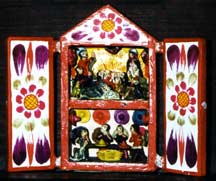|
|
|
|
|
McQuilkin,
an award-winning poet and former director of the Sunken Garden Poetry
Festival, thinks of "Counting to Christmas" as a gift to friends,
both known and unknown, at Christmas time. Though many of the book's poems
have appeared in publications such as The Atlantic Monthly, Poetry,
Prairie Schooner, The Christian Science Monitor, and Yankee,
they were originally written as Christmas cards over a period of 25 years;
and McQuilkin hopes they will carry some of their original intent. The
contents of the book are arranged in a sequential pattern, beginning early in
December and progressing to Christmas Day. The poems may be read much as an
Advent calendar is opened -- one a day during the pre-Christmas season.
Printed on heavy, textured stock, this gift book is a work of art and
contains a number of poems based on works of art. The collection is marked by
both wit and lyricism, and is secular in tone -- one poem depicts a Zuni
solstice ceremony and many others focus on the natural world, although a good
number of the poems present traditional Christmas motifs. Read
some sample poems from the book. |
|
BOOK
STATISTICS ISBN:
0-9662783-3-x
|
CELEBRATION A dozen apples in
December shrink and wrinkle, go
from dark to darker, hang by
threads no thicker than our own. And yet how like to
ornaments a dozen apples in
December and how the sparrows,
reeling, wassail on the earth-gold
wine a dozen apples, aging,
brew beneath a low and
southern sun. |
|
GETAWAY after an
early work by Mack Burns, age 4 He crayoned
his first cr¸che in three parts. All’s
well at the top—the Firmament is solid:
heavenly blue. But the sky is trouble. It’s
full of what—stars or angels swarming
like a plague of leggy spiders. Just
above the manger is a star burst of
yellow from something like a Scud incoming. Part Three has the Baby Jesus the size
of his parents, his feet and head protruding
from a purple perambulator. A lush
brown, black-haired Mary, her arms
and one leg colored jaggedly, leans
forward as if to wheel the giant baby, hissing
to the blueblood blob of Joseph “Let’s
get out of here!” The
space around the shed is fire-orange except
for a—camel? Brown as Mary and
humped high as the ridgepole, it’s
kicking a hole in the siding. To knock sense
into Joseph’s head? Or show it’s
raring
to go? Maybe left by a Wise Man after he
informed on the king. But— shouldn’t
it be a donkey? A minor mistake. Thank
God for its headstrong headful of a stall somewhere Herod never heard of. |
|
NOELING
IN THE HOOSEGOW for
Gladys Egdahl When the church burned down that December, town hall had to serve. Rose pumped an old foot-organ so hard she pounded the floor above the heads of the drunks in the lock-up below. She meant it, was fiercely in favor of God but not of how when God Rest Ye Merry Gentlemen ended, it didn’t in the underworld, accompanied by banging and jangling of bars, slurring into Away In A Manger off key but softly softly, until Rose played along. This time she did her pumping gently. Being six, I said it was wise men. No one said no. |
THE REVEREND ROBERT WALKER
SKATES
on
Duddingston Loch at sunset in
black—black top hat and frock coat, britches,
garters, stockings, skating shoes black.
Except for pink laces and the flush
on his face, slightly deeper at the
ears, he is
black as his Advent sermon. Oh yes,
his scarf is white. And if I say the ice is
black, I mean it’s not, is in fact a window
for fish. The
Reverend has turned his back on the sky between
the hills, which is the color of his ears. His
right leg is raised, extends behind him like the
long tail feathers of some exotic bird. He is
leaning into the wind, leading
with the sharpened blade of his nose, arms
wrapped one inside the other. Or so
Sir Henry Raeburn, R.A., did him in oils,
c. 1794. Those
fine cross-hatchings on the Loch are not
from all the Reverend’s parishioners celebrating
after service, skating up a storm, for the
hills and the sky seem no less skated
upon. It’s
Time. As surely as ice, oils crack. Nor is
the clerical top hat what it was. Look closely.
You’ll find the ghost of its earlier brim, painted
out imperfectly, is aimed low as if a
moment ago the vicar was searching for a
flashy trout. He has,
it appears, raised his sights to the deepening blue of night,
or something more distant. He dedicates a
miracle to it, no major miracle, mind
you, but still he makes his turn (notice the
sliver of ice kicked up by the heel of his
skate), has all but completed the figure
6 he means to raise to an 8. |
